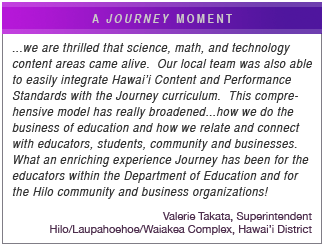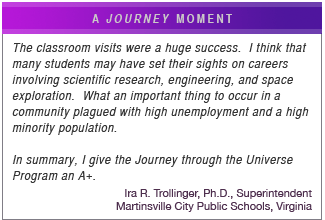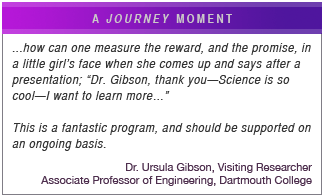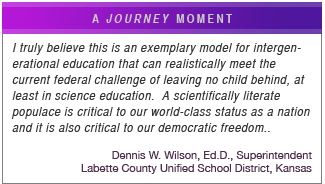|
|
 |
| |
|

At a time when there is a great disparity in educational preparedness
for students across America...
At a time when it should be the birthright of all students
to have an education that allows them to successfully enter the high
technology job markets of the 21st century...
At a
time when America must inspire the next generation
of scientists and engineers if we as a nation are to compete in the
emerging technology markets of the 21st century...
|
| |
 |
|
Journey through the Universe is committed
to strategic national needs in STEM education and workforce development
through content designed to national standards in the Earth and space
sciences, and customizable to local curricula; and an ability to
address requirements of the No Child Left Behind Act (NCLB) of 2001,
with special emphasis on under-served communities.
We believe that continuing America’s legacy as a
leader on science and technology frontiers well into the 21st century
will enable human exploration for generations to come. America has
been, and must continue to be an agent for international partnerships
meant to promote the legacy of human exploration worldwide.
|
| |
 |
|
America’s leadership in science and technology
markets has helped secure the standard of living Americans have enjoyed
for decades. Currently the U.S. employs close to one-third of the
worlds researchers in science and engineering, and accounts for 40% of
all R&D spending, though possesses only 5% of the world population.
Yet at the dawn of the 21st century the United
States faces an unprecedented level of global competition in emerging
science and technology markets, and whose sobering consequences are
addressed in a February 2006 report to Congress of the National Academy
of Sciences titled Rising Above the Gathering Storm: Energizing
and Employing America for a Brighter Economic Future.
One driver of emerging markets is innovation-based
development in science and technology, and in this context, American
innovation must be the means to maintain a leadership role. Yet
America’s technical workforce is aging, and the number of students
choosing careers in science and technology fields—and who are also U.S.
citizens—is decreasing.
As a benchmark, Goldman Sachs projects that the
combined economies of the BRICs (Brazil, Russia, India, and China) can
surpass those of the G6 in just 40 years. Long term strategic planning
to ensure U.S. competitiveness into the future is required now. In this
context, the engineers entering the job market in just ten
years are currently in 6th grade. Science
education programming that can captivate and inspire, deliver on
curricular requirements and national benchmarks, and target even
elementary school grades, is now of national strategic importance.
The February 2006 report of the National
Academies has served as a catalyst for legislation that comprises the
America COMPETES (Creating Opportunities to Meaningfully Promote
Excellence in Technology, Education, and Science) Act, signed into law
August 9, 2007. COMPETES includes a number of initiatives in education,
including: grants to States for alignment of K-12 education content
with the skills and knowledge necessary for successful entry into
post-secondary STEM education, and downstream entry into the workforce;
added training for thousands of teachers in STEM disciplines; creation
of new schools serving entire States and specializing in STEM
education; partnerships between high-need high schools and local
National Labs to create STEM educational centers of excellence; and the
training of more teachers equipped to teach AP courses in STEM
disciplines.
|
| |
 |
|
From a real-world vantage point, national
standards in STEM were designed to define the knowledge to be imparted
to students to ensure both a public literate in STEM disciplines and a
next generation of scientists and engineers—both of which are of
national importance in an age of high technology. National standards
relevant to the Earth and space sciences are now strongly reflected at
the state level, and most often in curricula at the school district
level. It is also the case, however, that local curricula often place
too high an emphasis on information at the expense of conceptual
understanding.
The purpose of the No Child Left Behind (NCLB)
Act of 2001 is increasing student achievement—for all students—through
accountability by states, school districts, and individual schools. Key
elements of NCLB implementation include standardized testing at the
state level, benchmarks for teacher competence, and school districts’
added emphasis on student achievement in under-served communities. The
premise for the name ‘No Child Left Behind’ is that a standards-based
approach to education would apply the same expectations to all students
as a means of addressing the disparity in student performance across
socio-economic and racial lines. The content focus was initially on
reading and mathematics, with testing in science beginning at the end
of the 2007-08 academic year.
The implementation of this legislation has been
controversial relative to: disparity in student achievement
expectations across states, level of federal funding, the emphasis on
reading and math at the expense of other subjects—including science,
the resultant emphasis on ‘teaching to the test’, and the application
of incentives and penalties. But the sentiment—increasing student
achievement, reaching out to under-served and under-represented
populations, and ensuring teacher competence—are all of national
strategic importance.
National legislation and national standards
therefore drive strategic educational need at the local level in terms
of content, professional development for teachers, and student
achievement for all students.
|
| |
 |
|
1. Alignment
with Standards and Customization
Journey through the Universe program
content deeply reflects grade K-12 national science education standards
that incorporate the current understanding of our world and the
Universe, and how we have come to know it. The grade
K-12 Education Modules address an understanding of Earth systems,
Earth in the Solar System, comparative planetary studies, and the Sun’s
place in the galaxy and universe—all key conceptual elements of the
Earth and space science curriculum for school districts across the
nation. The Journey through the Universe program pedagogy places content within the context of
the scientific process, which directly addresses process standards and
the nature of science as a human endeavor. The pedagogy is reflected in
how the Visiting Researchers
deliver programs and through the instructional
design of the Education Modules.
 Taken
together, the Modules’ content is broad enough for it to be mapped onto
a school district’s standards of teaching and learning in the Earth and
space sciences, and a customized compendium of lessons, at particular
grade levels, can be assembled for implementation as some or all of the
district’s curriculum. Taken
together, the Modules’ content is broad enough for it to be mapped onto
a school district’s standards of teaching and learning in the Earth and
space sciences, and a customized compendium of lessons, at particular
grade levels, can be assembled for implementation as some or all of the
district’s curriculum.
2. Emphasis on
Under-served Communities—We Believe in Opportunity For All
We believe that everyone has the right to an opportunity to learn about
their world and the greater Universe, the tools and training to
maximize success as a life-long learner, and the chance to revel in the
joys of learning. Given the great inequity in educational opportunities
and experiences across socio-economic class, Journey through the
Universe places special emphasis on programs that reach
under-served communities, in fact the program exclusively
served these communities from 1997-2006. While the program is now open
to all communities, our heritage reflects a commitment to underserved
populations in the inner-city (e.g., Washington, DC)
and in rural areas (e.g., Nogales, Arizona), and we are committed to
continue serving those that are most in need of the programming we
offer. 
3. Reaching Out
to Under-represented Groups —Creating Heroes for All
To inspire students that reflect groups under-represented in science
and technology fields, e.g., minorities and women, we recognize the
power of role models, and work to promote a diverse team of Visiting
Researchers that can serve as heroes to the next generation.
Role model diversity is evident in the corps of
114 scientists and engineers that have participated as Journey
through the Universe Visiting Researchers: 41 are women and 15 are
African-American. Meet some of the Visiting Researchers: 1, 2, 3, 4, 5, 6, 7.
4. Addressing
NCLB Science Requirements—We Believe in Supporting the Educational
Community
Science
testing now mandated by NCLB is driving school districts to integrate
more science into the curriculum, increase science instruction time
in the classroom, provide new professional development opportunities
for teachers, and assess whether the introduction of these new
resources will provide the needed ‘return on investment’ with regard to
student achievement.
Journey through the Universe provides
flexible Earth and space science content across grades K-20 that can be
customized to curricular need; offers a whole suite of professional development programs customizable
to specific workshop outcomes; engages thousands
of students in the community with real scientists and engineers;
provides science education programs for families;
provides baseline assessment for all
programming; and will work with a school district to develop customized assessment of impact on student
achievement as measured through benchmark and standardized testing.
|
|
|
